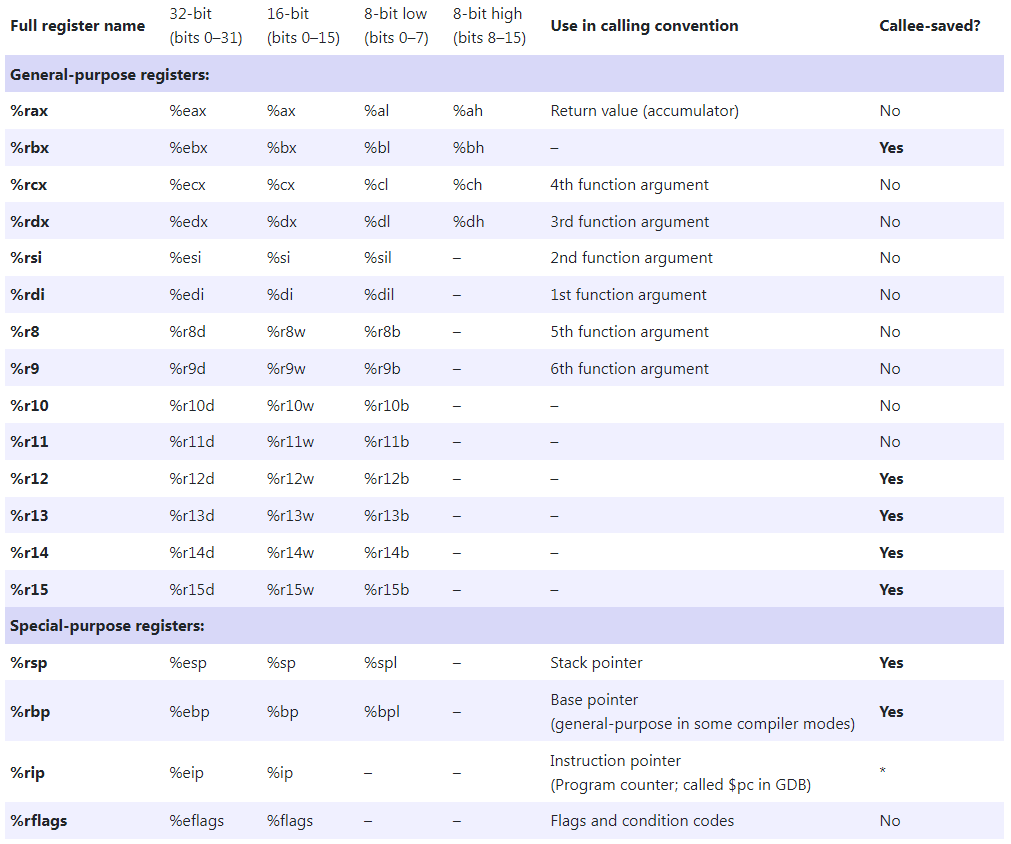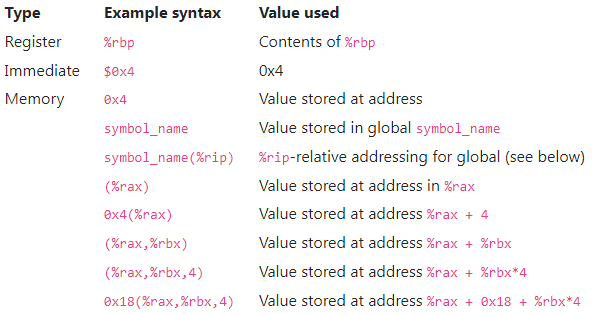x86_64汇编基础:Basics
参考
正文
Registers
Registers are the fastest kind of memory available in the machine. x86-64 has 14 general-purpose registers and several special-purpose registers. This table gives all the basic registers, with special-purpose registers highlighted in yellow. You’ll notice different naming conventions, a side effect of the long history of the x86 architecture (the 8086 was first released in 1978).

Note that unlike primary memory (which is what we think of when we discuss memory in a C/C++ program), registers have no addresses! There is no address value that, if cast to a pointer and dereferenced, would return the contents of the %rax register. Registers live in a separate world from the memory whose contents are partially prescribed by the C abstract machine.
The %rbp register has a special purpose: it points to the bottom of the current function’s stack frame, and local variables are often accessed relative to its value. However, when optimization is on, the compiler may determine that all local variables can be stored in registers. This frees up %rbp for use as another general-purpose register.
The relationship between different register bit widths is a little weird.
- Loading a value into a 32-bit register name sets the upper 32 bits of the register to zero. Thus, after movl $-1, %eax, the %rax register has value 0x00000000FFFFFFFF.
- Loading a value into a 16- or 8-bit register name leaves all other bits unchanged.
There are special instructions for loading signed and unsigned 8-, 16-, and 32-bit quantities into registers, recognizable by instruction suffixes. For instance, movzbl moves an 8-bit quantity (a byte) into a 32-bit register (a longword) with zero extension; movslq moves a 32-bit quantity (longword) into a 64-bit register (quadword) with sign extension. There’s no need for movzlq (why?).
Instruction format
The basic kinds of assembly instructions are:
- Computation. These instructions perform computation on values, typically values stored in registers. Most have zero or one source operands and one source/destination operand, with the source operand coming first. For example, the instruction addq %rax, %rbx performs the computation %rbx := %rbx + %rax.
- Data movement. These instructions move data between registers and memory. Almost all have one source operand and one destination operand; the source operand comes first.
- Control flow. Normally the CPU executes instructions in sequence. Control flow instructions change the instruction pointer in other ways. There are unconditional branches (the instruction pointer is set to a new value), conditional branches (the instruction pointer is set to a new value if a condition is true), and function call and return instructions.
(We use the “AT&T syntax” for x86-64 assembly. For the “Intel syntax,” which you can find in online documentation from Intel, see the Aside in CS:APP3e §3.3, p177, or Wikipedia, or other online resources. AT&T syntax is distinguished by several features, but especially by the use of percent signs for registers. Sadly, the Intel syntax puts destination registers before source registers.)
Some instructions appear to combine computation and data movement. For example, given the C code int* ip; ... ++(*ip); the compiler might generate incl (%rax) rather than movl (%rax), %ebx; incl %ebx; movl %ebx, (%rax). However, the processor actually divides these complex instructions into tiny, simpler, invisible instructions called microcode, because the simpler instructions can be made to execute faster. The complex incl instruction actually runs in three phases: data movement, then computation, then data movement. This matters when we introduce parallelism.
Directives
Assembly generated by a compiler contains instructions as well as labels and directives. Labels look like labelname: or labelnumber:; directives look like .directivename arguments. Labels are markers in the generated assembly, used to compute addresses. We usually see them used in control flow instructions, as in jmp L3 (“jump to L3”). Directives are instructions to the assembler; for instance, the .globl L instruction says “label L is globally visible in the executable”, .align sets the alignment of the following data, .long puts a number in the output, and .text and .data define the current segment.
We also frequently look at assembly that is disassembled from executable instructions by GDB, objdump -d, or objdump -S. This output looks different from compiler-generated assembly: in disassembled instructions, there are no intermediate labels or directives. This is because the labels and directives disappear during the process of generating executable instructions.
For instance, here is some compiler-generated assembly:
.globl _Z1fiii
.type _Z1fiii, @function
_Z1fiii:
.LFB0:
cmpl %edx, %esi
je .L3
movl %esi, %eax
ret
.L3:
movl %edi, %eax
ret
.LFE0:
.size _Z1fiii, .-_Z1fiii
And a disassembly of the same function, from an object file:
0000000000000000 <_Z1fiii>:
0: 39 d6 cmp %edx,%esi
2: 74 03 je 7 <_Z1fiii+0x7>
4: 89 f0 mov %esi,%eax
6: c3 retq
7: 89 f8 mov %edi,%eax
9: c3 retq
Everything but the instructions is removed, and the helpful .L3 label has been replaced with an actual address. The function appears to be located at address 0. This is just a placeholder; the final address is assigned by the linking process, when a final executable is created.
Finally, here is some disassembly from an executable:
0000000000400517 <_Z1fiii>:
400517: 39 d6 cmp %edx,%esi
400519: 74 03 je 40051e <_Z1fiii+0x7>
40051b: 89 f0 mov %esi,%eax
40051d: c3 retq
40051e: 89 f8 mov %edi,%eax
400520: c3 retq
The instructions are the same, but the addresses are different. (Other compiler flags would generate different addresses.)
Address modes
Most instruction operands use the following syntax for values. (See also CS:APP3e Figure 3.3 in §3.4.1, p181.)

The full form of a memory operand is offset(base,index,scale), which refers to the address offset + base + index*scale. In 0x18(%rax,%rbx,4), %rax is the base, 0x18 the offset, %rbx the index, and 4 the scale. The offset (if used) must be a constant and the base (if used) must be a register; the scale must be either 1, 2, 4, or 8. The default offset, base, and index are 0, and the default scale is 1.
symbol_names are found only in compiler-generated assembly; disassembly uses raw addresses (0x601030) or %rip-relative offsets (0x200bf2(%rip)).
Jumps and function call instructions use different syntax 🤷🏽♀️: *, rather than (), represents indirection.

Address computations
The base(offset,index,scale) form compactly expresses many array-style address computations. It’s typically used with a mov-type instruction to dereference memory. However, the compiler can use that form to compute addresses, thanks to the lea (Load Effective Address) instruction.
For instance, in movl 0x18(%rax,%rbx,4), %ecx, the address %rax + 0x18 + %rbx*4 is computed, then immediately dereferenced: the 4-byte value located there is loaded into %ecx. In leaq 0x18(%rax,%rbx,4), %rcx, the same address is computed, but it is not dereferenced. Instead, the computed address is moved into register %rcx.
Thanks to lea, the compiler will also prefer the base(offset,index,scale) form over add and mov for certain computations on integers. For example, this instruction:
leaq (%rax,%rbx,2), %rcx
performs the function %rcx := %rax + 2 * %rbx, but in one instruction, rather than three (movq %rax, %rcx; addq %rbx, %rcx; addq %rbx, %rcx).
%rip-relative addressing
x86-64 code often refers to globals using %rip-relative addressing: a global variable named a is referenced as a(%rip) rather than a.
This style of reference supports position-independent code (PIC), a security feature. It specifically supports position-independent executables (PIEs), which are programs that work independently of where their code is loaded into memory.
To run a conventional program, the operating system loads the program’s instructions into memory at a fixed address that’s the same every time, then starts executing the program at its first instruction. This works great, and runs the program in a predictable execution environment (the addresses of functions and global variables are the same every time). Unfortunately, the very predictability of this environment makes the program easier to attack.
In a position-independent executable, the operating system loads the program at varying locations: every time it runs, the program’s functions and global variables have different addresses. This makes the program harder to attack (though not impossible).
Program startup performance matters, so the operating system doesn’t recompile the program with different addresses each time. Instead, the compiler does most of the work in advance by using relative addressing.
When the operating system loads a PIE, it picks a starting point and loads all instructions and globals relative to that starting point. The PIE’s instructions never refer to global variables using direct addressing: you’ll never see movl global_int, %eax. Globals are referenced relatively instead, using deltas relative to the next %rip: movl global_int(%rip), %eax. These relative addresses work great independent of starting point! For instance, consider an instruction located at (starting-point + 0x80) that loads a variable g located at (starting-point + 0x1000) into %rax. In a non-PIE, the instruction might be written movq 0x400080, %rax (in compiler output, movq g, %rax); but this relies on g having a fixed address. In a PIE, the instruction might be written movq 0xf80(%rip), %rax (in compiler output, movq g(%rip), %rax), which works out beautifully no matter the starting point.

本文来自博客园,作者:dolinux,未经同意,禁止转载


 浙公网安备 33010602011771号
浙公网安备 33010602011771号